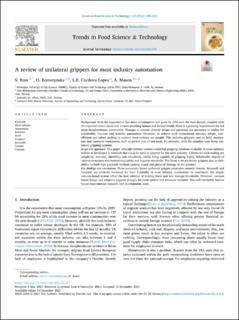| dc.contributor.author | Ross, Steven | |
| dc.contributor.author | Korostynska, Olga | |
| dc.contributor.author | Cordova-Lopez, Luis Eduardo | |
| dc.contributor.author | Mason, Alex | |
| dc.date.accessioned | 2023-02-06T11:29:41Z | |
| dc.date.available | 2023-02-06T11:29:41Z | |
| dc.date.created | 2022-01-13T16:00:18Z | |
| dc.date.issued | 2022-12-17 | |
| dc.identifier.citation | Trends in Food Science & Technology. 2022, 119 309-319. | en_US |
| dc.identifier.issn | 0924-2244 | |
| dc.identifier.uri | https://hdl.handle.net/11250/3048531 | |
| dc.description.abstract | With the expectation that meat consumption will grow by 12% over the next decade, coupled with the reported labour issues and viruses attacking human and animal health, there is a growing requirement for red meat slaughterhouse automation. Changes to current abattoir setups and processes are necessary to realise for sustainable, low-cost and scalable automation. However, to achieve such autonomous nirvana, simple, cost-efficient and robust tooling to support these systems are sought. This includes grippers used to hold, manipulate and transport workpieces, such as primal cuts of red meat, for example, with the simplest type being unilateral gripping systems. Scope and approach This paper critically reviews various unilateral gripping solutions available in cross-industry sectors or developed in research that could be used or adapted for the meat industry. Criteria for such tooling are simplicity, low-cost, durability and robustness, whilst being capable of gripping highly deformable objects of various structures and maintaining safety and hygiene standards. The focus is on air-driven grippers due to their ability to hold high payloads without causing visual and physical damage to the product. Key findings and conclusions Three pneumatic-based unilateral gripper principles, namely Coanda, Bernoulli and Vacuum, are critically reviewed for their feasibility in meat industry automation. In conclusion, the simple vacuum-based system offers the best solution of holding force and low damage thresholds. However, vacuum based design and adaption requires thought for meat surface and structure variance. This will inevitably lead to future experimental research and development work. | en_US |
| dc.language.iso | eng | en_US |
| dc.publisher | Elsevier | en_US |
| dc.relation.ispartofseries | Trends in Food Science & Technology;Volume 119 | |
| dc.relation.uri | https://www.sciencedirect.com/science/article/pii/S0924224421006749?via%3Dihub#! | |
| dc.rights | Navngivelse 4.0 Internasjonal | * |
| dc.rights | Navngivelse 4.0 Internasjonal | * |
| dc.rights.uri | http://creativecommons.org/licenses/by/4.0/deed.no | * |
| dc.subject | Meat industry | en_US |
| dc.subject | Automation | en_US |
| dc.subject | Robotics | en_US |
| dc.subject | EoAT | en_US |
| dc.subject | Grippers | en_US |
| dc.subject | Bernoulli principle | en_US |
| dc.title | A review of unilateral grippers for meat industry automation | en_US |
| dc.type | Peer reviewed | en_US |
| dc.type | Journal article | en_US |
| dc.description.version | publishedVersion | en_US |
| dc.rights.holder | © 2021 The Authors | en_US |
| cristin.ispublished | true | |
| cristin.fulltext | original | |
| cristin.qualitycode | 2 | |
| dc.identifier.doi | https://doi.org/10.1016/j.tifs.2021.12.017 | |
| dc.identifier.cristin | 1980657 | |
| dc.source.journal | Trends in Food Science & Technology | en_US |
| dc.source.volume | 119 | en_US |
| dc.source.issue | 119 | en_US |
| dc.source.pagenumber | 309-319 | en_US |
| dc.relation.project | Norges forskningsråd: 299757 | en_US |
| dc.relation.project | EU/871631 | en_US |
| dc.relation.project | Norges forskningsråd: 281234 | en_US |

